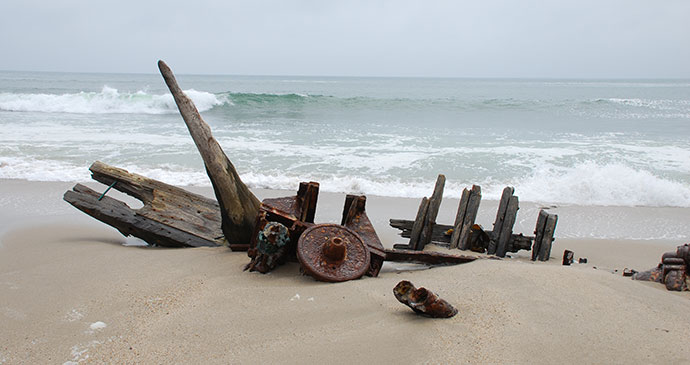Written by Nick Molloy
When a friend asked me to be the best man at his wedding in South Africa, I wasn’t going to acquiesce to his request without at least attempting a long-held ambition: to find the world’s finest example of an ‘on-land shipwreck’. A simple internet search will typically produce lists by desk-bound amateurs who have never left the safety of their armchairs. I’m a genuine enthusiast, I’ve boarded these ships and I can assure you some of the best examples are in Namibia. They don’t appear in said lists because they are remote and not easy to access. Thus they remain a well-kept secret.
One famous shipwreck that does appear in the popular literature is the Eduard Bohlen. A 100m hulk apparently rotting in the desert, it was the inspiration for my quest when I first saw the image some 20 years ago. It recently appeared somewhat famously on the Amazon show The Grand Tour. The show’s producers tried to make out that it was difficult to access. In truth it’s quite easy.

It goes without saying that you will need a decent 4×4. Before landing in Namibia I had the grand idea of hiring a couple of dune buggies and using GPS co-ordinates to locate the wrecks. However, the country is divided up into a series of ‘concessions’ – basically, areas that have been handed to selected tour guides and access isn’t permitted without them. Some of these areas are diamond-mining areas, and intruders without permission might be shot. So I conceded and hired a Toyota Hilux for two weeks so that I could drive on roads for the long trips as well as negotiate the dunes when needed.
Before travelling, I undertook a lot of desk research, pinpointing the stories of the various wrecks with approximate co-ordinates. I scoured satellite maps and found three distinct images of what appeared to be large wrecks high and dry on beaches: the Otavi, the Eduard Bohlen and Barge 77.
The guidebooks tend to say there are visible wrecks in the Skeleton Coast National Park in the northern section of the country. In truth there is very little left other than a few bits of wood and scrap metal. Shifting sands may reveal bits of engine block or hide them completely. I refer to the wrecks of the South West Seal and the Winston. I did try to reach the wreck of the Montrose in the same area but it would have meant a three-mile trek across the dunes and the lazy man on the gate would not let me sleep in my vehicle due to a wandering lion. I ran out of time on a tight schedule, so can neither confirm nor deny whether there is anything left to see.
The Eduard Bohlen is a relatively easy drive from Walvis Bay, though you do need a guide. You just have to make sure the tide is out and beware the salt pans through Sandwich Harbour (your guide will assist with this). You will pass the wreck of the Shawnee (a small tug) on the way. The Eduard Bohlen ran aground in 1909 and now lies about 300m from the beach. The first sight of this rusting behemoth plays tricks with your head. How could such a massive ship get so far inland? In truth, it hasn’t moved; it still lies at sea level but now is partially buried by the shifting sands.
The remaining shipwrecks serve as a reminder of the treacherous fogs and strong currents found offshore © Tricia Hayne
I was told by many locals that Barge 77 no longer existed. My satellite image suggested something was still there. It lies deep in the diamond-mining area, not far from the South African border. Lewis Druker at Coastway Tours arranged access for us provided he drove us and we were followed by an official from the mining company in another vehicle!
The Otavi is the true belt holder of the best land-shipwreck title. Access – I again used Coastway Tours, who included trips to some old mining ghost towns – requires a full-day’s drive across the Namib Desert from Lüderitz. Some quite terrifyingly large dunes need to be navigated before a camp is finally reached.
The next day some easy desert driving for an hour or so will bring you to the base of a cliff. Some light scrambling will bring you to the top and a scene that looks like a film set from Pirates of the Caribbean. The Otavi ran aground in 1945 in a crescent bay. Protected first by miles and miles of the Namib Desert, then by high cliffs, its final guardians are 8,000 Cape fur seals frolicking around with their young in the wreck itself. It remains my favourite place I’ve been anywhere in the world for 30 minutes!
Literally only a few miles away from the Otavi is the wreck of the Arkona. While the South Africans in my small group went off to play dune driving, I hiked across some scarily large and steep dunes (the car would have had no hope) for a couple of kilometres to reach the small wreck poking out of the sand as the surf lapped against it.
For a visual picture of what could await you, click here.
Learn more about the Skeleton Coast and explore other Namibia highlights in our guidebook to the country:

